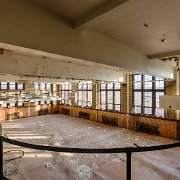
1 John Burroughs Intermediate / Crockett Technical High
Designed by the firm of Malcomson and Higginbotham, construction on the school began in 1925 and finished in January of 1927. Burroughs was named for John Burroughs, a naturalist and essayist. The school was laid out in an E shape with classrooms wings branching off from the center of the structure, which contained the gymnasiums, pool, auditorium, and library. Special classrooms for auto repair, woodworking, sewing, and bookkeeping. Like other intermediate schools built around the time there were separate gyms for boys and girls, though just one swimming pool.
Enrollment in the school quickly grew from 1,350 students in 1927 to 2,300 in 1936 - far above the designed capacity of 1,800 students. The neighborhood around Burroughs was ethnically diverse, supported in large part by the nearby auto factories. A strong bond between the community and the school formed during the Great Depression, when teachers sponsored needy families and donated their time to relief efforts.
By the 1970's, the neighborhood had started to thin out. The major auto plants nearby closed, starting with Packard in 1958, and Dodge Main closed in 1979. Houses were vacated and then abandoned, leaving holes in the neighborhood around Burroughs. As part of an effort to attract a large industrial company to the city, “renaissance zones” were established in distressed or underpopulated neighborhoods in 1997. The Detroit Economic Development Corporation began buying out the remaining 200 residents from the roughly 1 square kilometer neighborhood directly west of Burroughs. Nearly all of the houses in the neighborhood were gone by 2005, and by 2009 nature was starting to reclaim the empty streets.
The loss of the neighborhood led to a steep decline in enrollment. In 2003, Burroughs was one of 16 schools closed by the district, citing low test scores and disciplinary problems. Students were transfered to Cooper, which itself closed just a few years later in 2007. Initially Burroughs was going to receive the Academy of the Fine & Performing Arts, but instead reopened in 2005 as Crockett Technical High, which moved from its location in midtown. The program continued at the Burroughs building until 2012, when it closed permanently and students were relocated to the new East English Village High School.
By 2014 scrappers had begun to tear out all of the metal in the building, leaving it an empty shell.
Designed by the firm of Malcomson and Higginbotham, construction on the school began in 1925 and finished in January of 1927. Burroughs was named for John Burroughs, a naturalist and essayist. The school was laid out in an E shape with classrooms wings branching off from the center of the structure, which contained the gymnasiums, pool, auditorium, and library. Special classrooms for auto repair, woodworking, sewing, and bookkeeping. Like other intermediate schools built around the time there were separate gyms for boys and girls, though just one swimming pool.
Enrollment in the school quickly grew from 1,350 students in 1927 to 2,300 in 1936 - far above the designed capacity of 1,800 students. The neighborhood around Burroughs was ethnically diverse, supported in large part by the nearby auto factories. A strong bond between the community and the school formed during the Great Depression, when teachers sponsored needy families and donated their time to relief efforts.
By the 1970's, the neighborhood had started to thin out. The major auto plants nearby closed, starting with Packard in 1958, and Dodge Main closed in 1979. Houses were vacated and then abandoned, leaving holes in the neighborhood around Burroughs. As part of an effort to attract a large industrial company to the city, “renaissance zones” were established in distressed or underpopulated neighborhoods in 1997. The Detroit Economic Development Corporation began buying out the remaining 200 residents from the roughly 1 square kilometer neighborhood directly west of Burroughs. Nearly all of the houses in the neighborhood were gone by 2005, and by 2009 nature was starting to reclaim the empty streets.
The loss of the neighborhood led to a steep decline in enrollment. In 2003, Burroughs was one of 16 schools closed by the district, citing low test scores and disciplinary problems. Students were transfered to Cooper, which itself closed just a few years later in 2007. Initially Burroughs was going to receive the Academy of the Fine & Performing Arts, but instead reopened in 2005 as Crockett Technical High, which moved from its location in midtown. The program continued at the Burroughs building until 2012, when it closed permanently and students were relocated to the new East English Village High School.
By 2014 scrappers had begun to tear out all of the metal in the building, leaving it an empty shell.
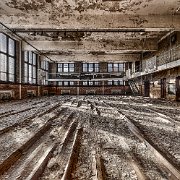
2 John Burroughs Intermediate / Crockett Technical High
Designed by the firm of Malcomson and Higginbotham, construction on the school began in 1925 and finished in January of 1927. Burroughs was named for John Burroughs, a naturalist and essayist. The school was laid out in an E shape with classrooms wings branching off from the center of the structure, which contained the gymnasiums, pool, auditorium, and library. Special classrooms for auto repair, woodworking, sewing, and bookkeeping. Like other intermediate schools built around the time there were separate gyms for boys and girls, though just one swimming pool.
Enrollment in the school quickly grew from 1,350 students in 1927 to 2,300 in 1936 - far above the designed capacity of 1,800 students. The neighborhood around Burroughs was ethnically diverse, supported in large part by the nearby auto factories. A strong bond between the community and the school formed during the Great Depression, when teachers sponsored needy families and donated their time to relief efforts.
By the 1970's, the neighborhood had started to thin out. The major auto plants nearby closed, starting with Packard in 1958, and Dodge Main closed in 1979. Houses were vacated and then abandoned, leaving holes in the neighborhood around Burroughs. As part of an effort to attract a large industrial company to the city, “renaissance zones” were established in distressed or underpopulated neighborhoods in 1997. The Detroit Economic Development Corporation began buying out the remaining 200 residents from the roughly 1 square kilometer neighborhood directly west of Burroughs. Nearly all of the houses in the neighborhood were gone by 2005, and by 2009 nature was starting to reclaim the empty streets.
The loss of the neighborhood led to a steep decline in enrollment. In 2003, Burroughs was one of 16 schools closed by the district, citing low test scores and disciplinary problems. Students were transfered to Cooper, which itself closed just a few years later in 2007. Initially Burroughs was going to receive the Academy of the Fine & Performing Arts, but instead reopened in 2005 as Crockett Technical High, which moved from its location in midtown. The program continued at the Burroughs building until 2012, when it closed permanently and students were relocated to the new East English Village High School.
By 2014 scrappers had begun to tear out all of the metal in the building, leaving it an empty shell.
Designed by the firm of Malcomson and Higginbotham, construction on the school began in 1925 and finished in January of 1927. Burroughs was named for John Burroughs, a naturalist and essayist. The school was laid out in an E shape with classrooms wings branching off from the center of the structure, which contained the gymnasiums, pool, auditorium, and library. Special classrooms for auto repair, woodworking, sewing, and bookkeeping. Like other intermediate schools built around the time there were separate gyms for boys and girls, though just one swimming pool.
Enrollment in the school quickly grew from 1,350 students in 1927 to 2,300 in 1936 - far above the designed capacity of 1,800 students. The neighborhood around Burroughs was ethnically diverse, supported in large part by the nearby auto factories. A strong bond between the community and the school formed during the Great Depression, when teachers sponsored needy families and donated their time to relief efforts.
By the 1970's, the neighborhood had started to thin out. The major auto plants nearby closed, starting with Packard in 1958, and Dodge Main closed in 1979. Houses were vacated and then abandoned, leaving holes in the neighborhood around Burroughs. As part of an effort to attract a large industrial company to the city, “renaissance zones” were established in distressed or underpopulated neighborhoods in 1997. The Detroit Economic Development Corporation began buying out the remaining 200 residents from the roughly 1 square kilometer neighborhood directly west of Burroughs. Nearly all of the houses in the neighborhood were gone by 2005, and by 2009 nature was starting to reclaim the empty streets.
The loss of the neighborhood led to a steep decline in enrollment. In 2003, Burroughs was one of 16 schools closed by the district, citing low test scores and disciplinary problems. Students were transfered to Cooper, which itself closed just a few years later in 2007. Initially Burroughs was going to receive the Academy of the Fine & Performing Arts, but instead reopened in 2005 as Crockett Technical High, which moved from its location in midtown. The program continued at the Burroughs building until 2012, when it closed permanently and students were relocated to the new East English Village High School.
By 2014 scrappers had begun to tear out all of the metal in the building, leaving it an empty shell.
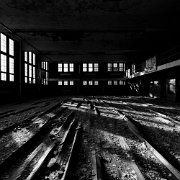
3 John Burroughs Intermediate / Crockett Technical High
Designed by the firm of Malcomson and Higginbotham, construction on the school began in 1925 and finished in January of 1927. Burroughs was named for John Burroughs, a naturalist and essayist. The school was laid out in an E shape with classrooms wings branching off from the center of the structure, which contained the gymnasiums, pool, auditorium, and library. Special classrooms for auto repair, woodworking, sewing, and bookkeeping. Like other intermediate schools built around the time there were separate gyms for boys and girls, though just one swimming pool.
Enrollment in the school quickly grew from 1,350 students in 1927 to 2,300 in 1936 - far above the designed capacity of 1,800 students. The neighborhood around Burroughs was ethnically diverse, supported in large part by the nearby auto factories. A strong bond between the community and the school formed during the Great Depression, when teachers sponsored needy families and donated their time to relief efforts.
By the 1970's, the neighborhood had started to thin out. The major auto plants nearby closed, starting with Packard in 1958, and Dodge Main closed in 1979. Houses were vacated and then abandoned, leaving holes in the neighborhood around Burroughs. As part of an effort to attract a large industrial company to the city, “renaissance zones” were established in distressed or underpopulated neighborhoods in 1997. The Detroit Economic Development Corporation began buying out the remaining 200 residents from the roughly 1 square kilometer neighborhood directly west of Burroughs. Nearly all of the houses in the neighborhood were gone by 2005, and by 2009 nature was starting to reclaim the empty streets.
The loss of the neighborhood led to a steep decline in enrollment. In 2003, Burroughs was one of 16 schools closed by the district, citing low test scores and disciplinary problems. Students were transfered to Cooper, which itself closed just a few years later in 2007. Initially Burroughs was going to receive the Academy of the Fine & Performing Arts, but instead reopened in 2005 as Crockett Technical High, which moved from its location in midtown. The program continued at the Burroughs building until 2012, when it closed permanently and students were relocated to the new East English Village High School.
By 2014 scrappers had begun to tear out all of the metal in the building, leaving it an empty shell.
Designed by the firm of Malcomson and Higginbotham, construction on the school began in 1925 and finished in January of 1927. Burroughs was named for John Burroughs, a naturalist and essayist. The school was laid out in an E shape with classrooms wings branching off from the center of the structure, which contained the gymnasiums, pool, auditorium, and library. Special classrooms for auto repair, woodworking, sewing, and bookkeeping. Like other intermediate schools built around the time there were separate gyms for boys and girls, though just one swimming pool.
Enrollment in the school quickly grew from 1,350 students in 1927 to 2,300 in 1936 - far above the designed capacity of 1,800 students. The neighborhood around Burroughs was ethnically diverse, supported in large part by the nearby auto factories. A strong bond between the community and the school formed during the Great Depression, when teachers sponsored needy families and donated their time to relief efforts.
By the 1970's, the neighborhood had started to thin out. The major auto plants nearby closed, starting with Packard in 1958, and Dodge Main closed in 1979. Houses were vacated and then abandoned, leaving holes in the neighborhood around Burroughs. As part of an effort to attract a large industrial company to the city, “renaissance zones” were established in distressed or underpopulated neighborhoods in 1997. The Detroit Economic Development Corporation began buying out the remaining 200 residents from the roughly 1 square kilometer neighborhood directly west of Burroughs. Nearly all of the houses in the neighborhood were gone by 2005, and by 2009 nature was starting to reclaim the empty streets.
The loss of the neighborhood led to a steep decline in enrollment. In 2003, Burroughs was one of 16 schools closed by the district, citing low test scores and disciplinary problems. Students were transfered to Cooper, which itself closed just a few years later in 2007. Initially Burroughs was going to receive the Academy of the Fine & Performing Arts, but instead reopened in 2005 as Crockett Technical High, which moved from its location in midtown. The program continued at the Burroughs building until 2012, when it closed permanently and students were relocated to the new East English Village High School.
By 2014 scrappers had begun to tear out all of the metal in the building, leaving it an empty shell.
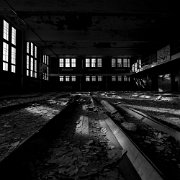
4 John Burroughs Intermediate / Crockett Technical High
Designed by the firm of Malcomson and Higginbotham, construction on the school began in 1925 and finished in January of 1927. Burroughs was named for John Burroughs, a naturalist and essayist. The school was laid out in an E shape with classrooms wings branching off from the center of the structure, which contained the gymnasiums, pool, auditorium, and library. Special classrooms for auto repair, woodworking, sewing, and bookkeeping. Like other intermediate schools built around the time there were separate gyms for boys and girls, though just one swimming pool.
Enrollment in the school quickly grew from 1,350 students in 1927 to 2,300 in 1936 - far above the designed capacity of 1,800 students. The neighborhood around Burroughs was ethnically diverse, supported in large part by the nearby auto factories. A strong bond between the community and the school formed during the Great Depression, when teachers sponsored needy families and donated their time to relief efforts.
By the 1970's, the neighborhood had started to thin out. The major auto plants nearby closed, starting with Packard in 1958, and Dodge Main closed in 1979. Houses were vacated and then abandoned, leaving holes in the neighborhood around Burroughs. As part of an effort to attract a large industrial company to the city, “renaissance zones” were established in distressed or underpopulated neighborhoods in 1997. The Detroit Economic Development Corporation began buying out the remaining 200 residents from the roughly 1 square kilometer neighborhood directly west of Burroughs. Nearly all of the houses in the neighborhood were gone by 2005, and by 2009 nature was starting to reclaim the empty streets.
The loss of the neighborhood led to a steep decline in enrollment. In 2003, Burroughs was one of 16 schools closed by the district, citing low test scores and disciplinary problems. Students were transfered to Cooper, which itself closed just a few years later in 2007. Initially Burroughs was going to receive the Academy of the Fine & Performing Arts, but instead reopened in 2005 as Crockett Technical High, which moved from its location in midtown. The program continued at the Burroughs building until 2012, when it closed permanently and students were relocated to the new East English Village High School.
By 2014 scrappers had begun to tear out all of the metal in the building, leaving it an empty shell.
Designed by the firm of Malcomson and Higginbotham, construction on the school began in 1925 and finished in January of 1927. Burroughs was named for John Burroughs, a naturalist and essayist. The school was laid out in an E shape with classrooms wings branching off from the center of the structure, which contained the gymnasiums, pool, auditorium, and library. Special classrooms for auto repair, woodworking, sewing, and bookkeeping. Like other intermediate schools built around the time there were separate gyms for boys and girls, though just one swimming pool.
Enrollment in the school quickly grew from 1,350 students in 1927 to 2,300 in 1936 - far above the designed capacity of 1,800 students. The neighborhood around Burroughs was ethnically diverse, supported in large part by the nearby auto factories. A strong bond between the community and the school formed during the Great Depression, when teachers sponsored needy families and donated their time to relief efforts.
By the 1970's, the neighborhood had started to thin out. The major auto plants nearby closed, starting with Packard in 1958, and Dodge Main closed in 1979. Houses were vacated and then abandoned, leaving holes in the neighborhood around Burroughs. As part of an effort to attract a large industrial company to the city, “renaissance zones” were established in distressed or underpopulated neighborhoods in 1997. The Detroit Economic Development Corporation began buying out the remaining 200 residents from the roughly 1 square kilometer neighborhood directly west of Burroughs. Nearly all of the houses in the neighborhood were gone by 2005, and by 2009 nature was starting to reclaim the empty streets.
The loss of the neighborhood led to a steep decline in enrollment. In 2003, Burroughs was one of 16 schools closed by the district, citing low test scores and disciplinary problems. Students were transfered to Cooper, which itself closed just a few years later in 2007. Initially Burroughs was going to receive the Academy of the Fine & Performing Arts, but instead reopened in 2005 as Crockett Technical High, which moved from its location in midtown. The program continued at the Burroughs building until 2012, when it closed permanently and students were relocated to the new East English Village High School.
By 2014 scrappers had begun to tear out all of the metal in the building, leaving it an empty shell.
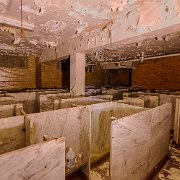
5 John Burroughs Intermediate / Crockett Technical High
Designed by the firm of Malcomson and Higginbotham, construction on the school began in 1925 and finished in January of 1927. Burroughs was named for John Burroughs, a naturalist and essayist. The school was laid out in an E shape with classrooms wings branching off from the center of the structure, which contained the gymnasiums, pool, auditorium, and library. Special classrooms for auto repair, woodworking, sewing, and bookkeeping. Like other intermediate schools built around the time there were separate gyms for boys and girls, though just one swimming pool.
Enrollment in the school quickly grew from 1,350 students in 1927 to 2,300 in 1936 - far above the designed capacity of 1,800 students. The neighborhood around Burroughs was ethnically diverse, supported in large part by the nearby auto factories. A strong bond between the community and the school formed during the Great Depression, when teachers sponsored needy families and donated their time to relief efforts.
By the 1970's, the neighborhood had started to thin out. The major auto plants nearby closed, starting with Packard in 1958, and Dodge Main closed in 1979. Houses were vacated and then abandoned, leaving holes in the neighborhood around Burroughs. As part of an effort to attract a large industrial company to the city, “renaissance zones” were established in distressed or underpopulated neighborhoods in 1997. The Detroit Economic Development Corporation began buying out the remaining 200 residents from the roughly 1 square kilometer neighborhood directly west of Burroughs. Nearly all of the houses in the neighborhood were gone by 2005, and by 2009 nature was starting to reclaim the empty streets.
The loss of the neighborhood led to a steep decline in enrollment. In 2003, Burroughs was one of 16 schools closed by the district, citing low test scores and disciplinary problems. Students were transfered to Cooper, which itself closed just a few years later in 2007. Initially Burroughs was going to receive the Academy of the Fine & Performing Arts, but instead reopened in 2005 as Crockett Technical High, which moved from its location in midtown. The program continued at the Burroughs building until 2012, when it closed permanently and students were relocated to the new East English Village High School.
By 2014 scrappers had begun to tear out all of the metal in the building, leaving it an empty shell.
Designed by the firm of Malcomson and Higginbotham, construction on the school began in 1925 and finished in January of 1927. Burroughs was named for John Burroughs, a naturalist and essayist. The school was laid out in an E shape with classrooms wings branching off from the center of the structure, which contained the gymnasiums, pool, auditorium, and library. Special classrooms for auto repair, woodworking, sewing, and bookkeeping. Like other intermediate schools built around the time there were separate gyms for boys and girls, though just one swimming pool.
Enrollment in the school quickly grew from 1,350 students in 1927 to 2,300 in 1936 - far above the designed capacity of 1,800 students. The neighborhood around Burroughs was ethnically diverse, supported in large part by the nearby auto factories. A strong bond between the community and the school formed during the Great Depression, when teachers sponsored needy families and donated their time to relief efforts.
By the 1970's, the neighborhood had started to thin out. The major auto plants nearby closed, starting with Packard in 1958, and Dodge Main closed in 1979. Houses were vacated and then abandoned, leaving holes in the neighborhood around Burroughs. As part of an effort to attract a large industrial company to the city, “renaissance zones” were established in distressed or underpopulated neighborhoods in 1997. The Detroit Economic Development Corporation began buying out the remaining 200 residents from the roughly 1 square kilometer neighborhood directly west of Burroughs. Nearly all of the houses in the neighborhood were gone by 2005, and by 2009 nature was starting to reclaim the empty streets.
The loss of the neighborhood led to a steep decline in enrollment. In 2003, Burroughs was one of 16 schools closed by the district, citing low test scores and disciplinary problems. Students were transfered to Cooper, which itself closed just a few years later in 2007. Initially Burroughs was going to receive the Academy of the Fine & Performing Arts, but instead reopened in 2005 as Crockett Technical High, which moved from its location in midtown. The program continued at the Burroughs building until 2012, when it closed permanently and students were relocated to the new East English Village High School.
By 2014 scrappers had begun to tear out all of the metal in the building, leaving it an empty shell.
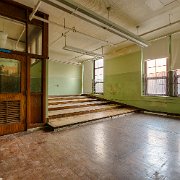
6 John Burroughs Intermediate / Crockett Technical High
Designed by the firm of Malcomson and Higginbotham, construction on the school began in 1925 and finished in January of 1927. Burroughs was named for John Burroughs, a naturalist and essayist. The school was laid out in an E shape with classrooms wings branching off from the center of the structure, which contained the gymnasiums, pool, auditorium, and library. Special classrooms for auto repair, woodworking, sewing, and bookkeeping. Like other intermediate schools built around the time there were separate gyms for boys and girls, though just one swimming pool.
Enrollment in the school quickly grew from 1,350 students in 1927 to 2,300 in 1936 - far above the designed capacity of 1,800 students. The neighborhood around Burroughs was ethnically diverse, supported in large part by the nearby auto factories. A strong bond between the community and the school formed during the Great Depression, when teachers sponsored needy families and donated their time to relief efforts.
By the 1970's, the neighborhood had started to thin out. The major auto plants nearby closed, starting with Packard in 1958, and Dodge Main closed in 1979. Houses were vacated and then abandoned, leaving holes in the neighborhood around Burroughs. As part of an effort to attract a large industrial company to the city, “renaissance zones” were established in distressed or underpopulated neighborhoods in 1997. The Detroit Economic Development Corporation began buying out the remaining 200 residents from the roughly 1 square kilometer neighborhood directly west of Burroughs. Nearly all of the houses in the neighborhood were gone by 2005, and by 2009 nature was starting to reclaim the empty streets.
The loss of the neighborhood led to a steep decline in enrollment. In 2003, Burroughs was one of 16 schools closed by the district, citing low test scores and disciplinary problems. Students were transfered to Cooper, which itself closed just a few years later in 2007. Initially Burroughs was going to receive the Academy of the Fine & Performing Arts, but instead reopened in 2005 as Crockett Technical High, which moved from its location in midtown. The program continued at the Burroughs building until 2012, when it closed permanently and students were relocated to the new East English Village High School.
By 2014 scrappers had begun to tear out all of the metal in the building, leaving it an empty shell.
Designed by the firm of Malcomson and Higginbotham, construction on the school began in 1925 and finished in January of 1927. Burroughs was named for John Burroughs, a naturalist and essayist. The school was laid out in an E shape with classrooms wings branching off from the center of the structure, which contained the gymnasiums, pool, auditorium, and library. Special classrooms for auto repair, woodworking, sewing, and bookkeeping. Like other intermediate schools built around the time there were separate gyms for boys and girls, though just one swimming pool.
Enrollment in the school quickly grew from 1,350 students in 1927 to 2,300 in 1936 - far above the designed capacity of 1,800 students. The neighborhood around Burroughs was ethnically diverse, supported in large part by the nearby auto factories. A strong bond between the community and the school formed during the Great Depression, when teachers sponsored needy families and donated their time to relief efforts.
By the 1970's, the neighborhood had started to thin out. The major auto plants nearby closed, starting with Packard in 1958, and Dodge Main closed in 1979. Houses were vacated and then abandoned, leaving holes in the neighborhood around Burroughs. As part of an effort to attract a large industrial company to the city, “renaissance zones” were established in distressed or underpopulated neighborhoods in 1997. The Detroit Economic Development Corporation began buying out the remaining 200 residents from the roughly 1 square kilometer neighborhood directly west of Burroughs. Nearly all of the houses in the neighborhood were gone by 2005, and by 2009 nature was starting to reclaim the empty streets.
The loss of the neighborhood led to a steep decline in enrollment. In 2003, Burroughs was one of 16 schools closed by the district, citing low test scores and disciplinary problems. Students were transfered to Cooper, which itself closed just a few years later in 2007. Initially Burroughs was going to receive the Academy of the Fine & Performing Arts, but instead reopened in 2005 as Crockett Technical High, which moved from its location in midtown. The program continued at the Burroughs building until 2012, when it closed permanently and students were relocated to the new East English Village High School.
By 2014 scrappers had begun to tear out all of the metal in the building, leaving it an empty shell.
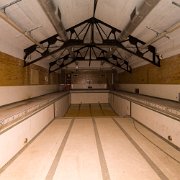
7 John Burroughs Intermediate / Crockett Technical High
Designed by the firm of Malcomson and Higginbotham, construction on the school began in 1925 and finished in January of 1927. Burroughs was named for John Burroughs, a naturalist and essayist. The school was laid out in an E shape with classrooms wings branching off from the center of the structure, which contained the gymnasiums, pool, auditorium, and library. Special classrooms for auto repair, woodworking, sewing, and bookkeeping. Like other intermediate schools built around the time there were separate gyms for boys and girls, though just one swimming pool.
Enrollment in the school quickly grew from 1,350 students in 1927 to 2,300 in 1936 - far above the designed capacity of 1,800 students. The neighborhood around Burroughs was ethnically diverse, supported in large part by the nearby auto factories. A strong bond between the community and the school formed during the Great Depression, when teachers sponsored needy families and donated their time to relief efforts.
By the 1970's, the neighborhood had started to thin out. The major auto plants nearby closed, starting with Packard in 1958, and Dodge Main closed in 1979. Houses were vacated and then abandoned, leaving holes in the neighborhood around Burroughs. As part of an effort to attract a large industrial company to the city, “renaissance zones” were established in distressed or underpopulated neighborhoods in 1997. The Detroit Economic Development Corporation began buying out the remaining 200 residents from the roughly 1 square kilometer neighborhood directly west of Burroughs. Nearly all of the houses in the neighborhood were gone by 2005, and by 2009 nature was starting to reclaim the empty streets.
The loss of the neighborhood led to a steep decline in enrollment. In 2003, Burroughs was one of 16 schools closed by the district, citing low test scores and disciplinary problems. Students were transfered to Cooper, which itself closed just a few years later in 2007. Initially Burroughs was going to receive the Academy of the Fine & Performing Arts, but instead reopened in 2005 as Crockett Technical High, which moved from its location in midtown. The program continued at the Burroughs building until 2012, when it closed permanently and students were relocated to the new East English Village High School.
By 2014 scrappers had begun to tear out all of the metal in the building, leaving it an empty shell.
Designed by the firm of Malcomson and Higginbotham, construction on the school began in 1925 and finished in January of 1927. Burroughs was named for John Burroughs, a naturalist and essayist. The school was laid out in an E shape with classrooms wings branching off from the center of the structure, which contained the gymnasiums, pool, auditorium, and library. Special classrooms for auto repair, woodworking, sewing, and bookkeeping. Like other intermediate schools built around the time there were separate gyms for boys and girls, though just one swimming pool.
Enrollment in the school quickly grew from 1,350 students in 1927 to 2,300 in 1936 - far above the designed capacity of 1,800 students. The neighborhood around Burroughs was ethnically diverse, supported in large part by the nearby auto factories. A strong bond between the community and the school formed during the Great Depression, when teachers sponsored needy families and donated their time to relief efforts.
By the 1970's, the neighborhood had started to thin out. The major auto plants nearby closed, starting with Packard in 1958, and Dodge Main closed in 1979. Houses were vacated and then abandoned, leaving holes in the neighborhood around Burroughs. As part of an effort to attract a large industrial company to the city, “renaissance zones” were established in distressed or underpopulated neighborhoods in 1997. The Detroit Economic Development Corporation began buying out the remaining 200 residents from the roughly 1 square kilometer neighborhood directly west of Burroughs. Nearly all of the houses in the neighborhood were gone by 2005, and by 2009 nature was starting to reclaim the empty streets.
The loss of the neighborhood led to a steep decline in enrollment. In 2003, Burroughs was one of 16 schools closed by the district, citing low test scores and disciplinary problems. Students were transfered to Cooper, which itself closed just a few years later in 2007. Initially Burroughs was going to receive the Academy of the Fine & Performing Arts, but instead reopened in 2005 as Crockett Technical High, which moved from its location in midtown. The program continued at the Burroughs building until 2012, when it closed permanently and students were relocated to the new East English Village High School.
By 2014 scrappers had begun to tear out all of the metal in the building, leaving it an empty shell.
Crockett School